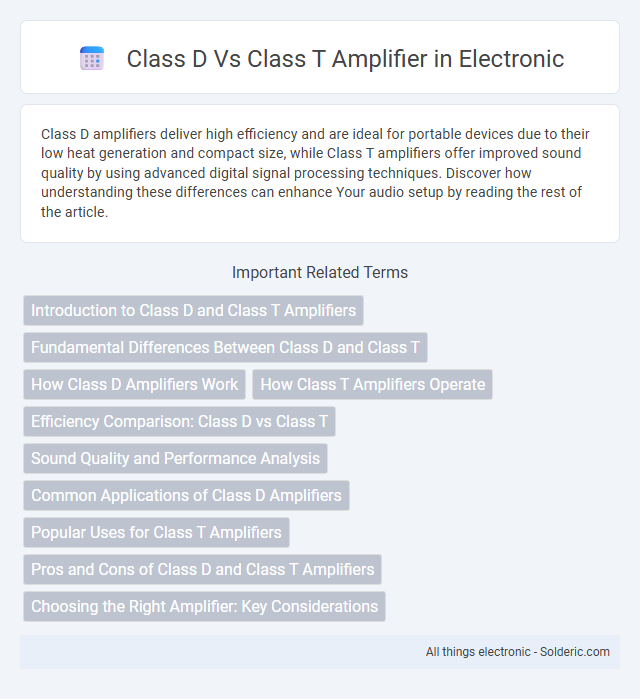Class D amplifiers deliver high efficiency and are ideal for portable devices due to their low heat generation and compact size, while Class T amplifiers offer improved sound quality by using advanced digital signal processing techniques. Discover how understanding these differences can enhance Your audio setup by reading the rest of the article.
Comparison Table
| Feature | Class D Amplifier | Class T Amplifier |
|---|---|---|
| Amplification Method | Pulse-width modulation (PWM) | Enhanced Class D with proprietary DSP |
| Efficiency | Typically 85-95% | Up to 95%+ |
| Sound Quality | Good; potential switching noise | Improved clarity and reduced distortion |
| Heat Dissipation | Low heat generation | Minimal heat due to optimized switching |
| Application | General audio, car systems, portable speakers | High-fidelity audio, premium speakers |
| Cost | Usually lower | Higher due to advanced tech |
| Complexity | Simpler circuit design | More complex; requires DSP control |
Introduction to Class D and Class T Amplifiers
Class D and Class T amplifiers are both types of switching amplifiers known for their high efficiency and compact size. Class D amplifiers use pulse-width modulation (PWM) to achieve amplified output by switching transistors fully on or off, minimizing power loss. Class T amplifiers, a proprietary variation of Class D, incorporate advanced modulation techniques and digital signal processing for improved audio quality and reduced distortion, making them a popular choice for your high-fidelity audio needs.
Fundamental Differences Between Class D and Class T
Class D amplifiers operate using pulse-width modulation (PWM) to switch output transistors fully on or off, achieving high efficiency by minimizing power loss through continuous switching. Class T amplifiers, a proprietary variation of Class D technology developed by Tripath, incorporate advanced digital signal processing and adaptive pulse modulation to enhance audio fidelity and reduce distortion. Your choice between Class D and Class T affects audio performance and efficiency, with Class T providing superior sound quality due to its optimized modulation techniques.
How Class D Amplifiers Work
Class D amplifiers operate using pulse-width modulation (PWM) to convert analog audio signals into a series of high-frequency digital pulses, which drive the output transistors as switches. This switching operation generates minimal heat and allows for high efficiency, often exceeding 90%, making Class D amps ideal for portable and power-sensitive applications. Your audio signal is reconstructed at the output through low-pass filtering, delivering clean and powerful sound with reduced energy loss.
How Class T Amplifiers Operate
Class T amplifiers operate using a proprietary modulation technique that combines the efficiency of Class D amplifiers with enhanced signal processing for improved sound quality. They employ digital signal processing (DSP) to dynamically adjust switching frequencies and reduce distortion and noise, resulting in high-fidelity audio output. This approach allows Class T amplifiers to deliver powerful amplification with minimal heat generation and energy loss.
Efficiency Comparison: Class D vs Class T
Class D amplifiers typically achieve efficiency rates around 85-95%, utilizing pulse-width modulation to minimize power loss and heat generation. Class T amplifiers, a proprietary variant of Class D technology developed by Tripath, enhance efficiency further through advanced digital signal processing and modulation techniques, sometimes surpassing 90% efficiency with improved audio fidelity. Both amplifier classes excel in energy efficiency compared to traditional Class AB amplifiers, but Class T emphasizes superior sound quality alongside high efficiency.
Sound Quality and Performance Analysis
Class D amplifiers offer high efficiency and compact design but may exhibit higher distortion and noise levels compared to Class T amplifiers. Class T amplifiers, a refined variation of Class D technology, employ advanced digital signal processing techniques to deliver superior sound quality with reduced harmonic distortion and improved dynamic response. Choosing Your amplifier depends on prioritizing either energy efficiency and size (Class D) or enhanced audio fidelity and performance (Class T).
Common Applications of Class D Amplifiers
Class D amplifiers are widely used in portable audio devices, car audio systems, and home theater receivers due to their high efficiency and compact size. Their ability to produce minimal heat and consume less power makes them ideal for battery-powered applications and space-constrained environments. Your choice of a Class D amplifier can enhance performance in scenarios demanding lightweight, energy-saving audio solutions.
Popular Uses for Class T Amplifiers
Class T amplifiers are widely used in portable audio devices, such as Bluetooth speakers and headphones, due to their high efficiency and compact size. Your audio setup benefits from Class T's ability to deliver powerful sound output with minimal heat generation, making them ideal for battery-powered applications. These amplifiers also find popularity in car audio systems, providing clear sound quality without draining the vehicle's power supply.
Pros and Cons of Class D and Class T Amplifiers
Class D amplifiers offer high efficiency up to 90%, compact size, and reduced heat dissipation, making them ideal for portable and battery-powered devices, but they may suffer from higher electromagnetic interference (EMI) and lower audio fidelity compared to linear amplifiers. Class T amplifiers, a refined subset of Class D technology pioneered by Tripath, improve sound quality with enhanced signal processing and modulation methods, delivering better audio clarity and lower distortion while maintaining high efficiency. However, Class T amps tend to be more expensive and less widely available, limiting their use primarily to high-end audio applications.
Choosing the Right Amplifier: Key Considerations
Class D amplifiers offer high efficiency and compact size, making them ideal for battery-powered and portable devices, while Class T amplifiers, a variant of Class D, provide enhanced audio fidelity through advanced modulation techniques. Your choice depends on prioritizing either power efficiency for extended usage or superior sound quality for critical listening environments. Evaluating factors like thermal management, distortion levels, and application context will help determine the optimal amplifier class for your audio setup.
class d vs class t amplifier Infographic

 solderic.com
solderic.com